Prove It To Me - Real Research, Real Data, No BS
Do you get tired of big ideas, exorbitant pitches, inactionable concepts, and empty promises? Cool, me too. I’m Dr. Matt Law, and I’m the host of ”Prove It To Me”. This podcast aims to put theories to the test and bring good research to light by showcasing evidence-based solutions. Guests will be challenged to identify things that actually work, provide research and data to back up their claims, and tell us how to measure and manage real solutions. You’ll hear about a lot of environmental health and occupational safety theories and concepts, but you’ll also learn about general business solutions and maybe even some everyday things that you can apply to your life. We’ll also cover general topics about research, whether it be about measurement tools, statistics, or what differentiates good research from, well, the not so good information out there. ”Prove It To Me” is nerdy. It is serious. It is jovial and fun. It is optionally explicit, but your kids will probably be asleep before we get to any bad stuff anyway. If you’re ready to cut through the BS, maybe learn a little bit about research, and get into the nitty gritty of whether big ideas work or not, you’re in the right place. Have some evidence-based research to share? Send an email to contact@proveitpod.com today! Disclaimer: The views and opinions expressed in this podcast are those of the host and its guests and do not necessarily represent the official position, opinion, or strategies of their employers or companies. Examples of research and data analysis discussed within this podcast are only examples. They should not be utilized in the real world as the only solution available as they are based on very limited, often single-use case, and sometimes dated information. Assumptions made within this discussion about research and data analyses are not necessarily representative of the position of the host, the guests, or their employers or companies. No part of this podcast may be reproduced, stored in a retrieval system, or transmitted in any form or by any means, mechanical, electronic, recording, or otherwise without prior written permission of the creator of the podcast. The presentation of content by the guests does not necessarily constitute an active endorsement of the content by the host.
Episodes

2 hours ago
2 hours ago
In this brand new episode of #ProveItPod, Dr. Matt Law gives up the host chair to Wyatt Bradbury for a quirky yet critical year-in-review about the podcast. Who is the best Batman, and what's in store for next year?
Listen now at www.proveitpod.com or wherever you get your podcasts, and find the full video at https://youtu.be/YJrPZ8fmbqY

Friday Oct 10, 2025
Friday Oct 10, 2025
In this brand new episode of #ProveItPod, Dr. Matt Law talks to Georgia Bryce-Hutchinson about addressing mental health and psychosocial hazards through corporate therapy solutions and relying on subject matter experts. Are your workers at risk?
Listen now at www.proveitpod.com or wherever you get your podcasts!
About Georgia Bryce-Hutchinson:
Georgia A. Bryce-Hutchinson is a Licensed Marriage and Family Therapist, Workplace Mental Health Consultant & Trainer, and Certified Professional Life Coach at Building Families According to Pattern, LLC. With a background in Environmental Engineering, she brings a systems-thinking approach to corporate mental health—designing strategic coaching and training solutions that reduce stress, build resilience, and enhance wellbeing. Georgia partners with organizations to advance psychological health and safety, crisis response, and leadership development, driving employee engagement, retention, and performance. She has delivered high-impact keynotes and technical presentations for the ASSP, NSC, General Motors, Veriforce, Georgia Safety Conference, and more. Since 2022, she has led mental health initiatives for L’Oréal, facilitating programs for emergency response teams, frontline leaders, and HR professionals. As a Safety FOCUS trainer with ASSP, she champions wellness among safety professionals. Widely recognized in both traditional and digital media, Georgia is a trusted voice on workplace mental health and employee wellbeing.
Episode Resources:
Building Families According To Pattern, LLC with Georgia Bryce-Hutchinsonwww.bfatpllc.com
LinkedInhttps://www.linkedin.com/in/georgiabryce/
Linked Newsletter – The Therapy Room and Beyondhttps://www.linkedin.com/newsletters/6883118076557053952/
Podcast Guest - Psych Health and Safety USA – “Work Shouldn’t Hurt Emotionally”https://youtu.be/IAQ3C83lzrQ?si=0Ak3I9qHonvpvdxJ

Friday Sep 26, 2025
Friday Sep 26, 2025
In this brand new episode of #ProveItPod, Dr. Matt Law talks to Dr. Fred Sherratt about social science methodologies, critical discourse analysis, and "safety without the spin". Do construction workers see through your bulls***?
Listen now at www.proveitpod.com or wherever you get your podcasts!
About Dr. Fred Sherratt:
Dr. Fred Sherratt is an internationally recognized, world-leading academic in the field of construction safety. A Chartered Builder and a Chartered Building Engineer, she has over ten years’ experience working on UK construction jobsites, with over another ten working as an academic in UK Universities. Her last role in the UK was as a Professor of Construction Sociology, and she moved to the US in 2022 to continue her work in the science of construction safety. Fred is currently joint coordinator of the international CIB research commission W099 Worker Health, Safety and Wellbeing in Construction, and has presented her work to academic and industry audiences around the world.
Episode Resources:
Unpacking Construction Site Safety https://a.co/d/1WQQogW
Sherratt F (2013) Et in Arcadia ego? 'Zero target' safety programmes in the UK construction industry. In: Smith, S D and Ahiaga-Dagbui, D D (Eds.), Proceedings 29th Annual ARCOM Conference, 2-4 September 2013, Reading, UK, Association of Researchers in Construction Management, 299–308 http://arcom.ac.uk/abstracts-results.php?title=&author=sherratt&keyword=&p=#7822
Exploring ‘Zero Target’ safety programmes in the UK construction industry: Construction Management and Economics: Vol 32, No 7-8 https://www.tandfonline.com/doi/abs/10.1080/01446193.2014.894248
Sherratt, F. and Dainty, A.R.J. (2017) UK construction safety: a zero paradox? Policy and Practice in Health and Safety, 15(2) 108-116. https://doi.org/10.1080/14773996.2017.1305040
Sherratt, F., Harch, D. and Perez, A. (2024) Making Zero Work for Construction Safety in a Post-Zero World, Journal of Safety Research, https://doi.org/10.1016/j.jsr.2024.08.016
Sherratt, F and Sherratt, S (2017) The Road To Hell: Worker Health, Safety And Wellbeing Within UK Corporate Social Responsibility Practices. In: Chan, P W and Neilson, C J (Eds.), Proceedings 33rd Annual ARCOM Conference, 4-6 September 2017, Fitzwilliam College, Cambridge, UK. Association of Researchers in Construction Management, 389–398 http://arcom.ac.uk/abstracts-results.php?title=&author=sherratt&keyword=&p=#13237

Friday Aug 01, 2025
Friday Aug 01, 2025
In this #StudyFinds episode of #ProveItPod, Dr. Matt Law dives into a recent study that explores how sleep can affect dark personality traits. Are your sleep habits sending you to the dark side? Listen now to find out!
Episode Resources:
Poor sleep can bring out workers' darker side, study finds - Safety+Health Magazine
Kuijpers, E., Vergauwe, J., Vanderperre, S., Mairesse, O., & Hofmans, J. (2025). Rise of the Dark Side: How Sleep Perception Triggers Dark Triad States at Work. Journal of Organizational Behavior. https://doi.org/10.1002/job.2885

Monday Jul 28, 2025
Monday Jul 28, 2025
In this compelling episode of #ProveItPod, Dr. Todd Loushine and Dr. Matt Law deconstruct traditional safety measurement approaches. They challenge listeners to think critically about how safety is defined, measured, and understood, exploring the complex relationship between data, perception, and workplace safety.
Listen now at www.proveitpod.com or wherever you get your podcasts!
Key highlights include:
Critiquing incident rate methodologies
Exploring statistical nuances in safety research
Discussing cognitive biases in safety interpretation
Demonstrating the limitations of current safety metrics
The presenters use real-world examples and academic research to illustrate how our current understanding of safety might be fundamentally flawed. They advocate for a more curious, experimental approach to safety management, emphasizing the importance of challenging assumptions and continuously learning.
Perfect for safety professionals, researchers, and anyone interested in understanding the deeper complexities of workplace safety beyond surface-level metrics.
Chapters:
Introduction of Speakers and Session Overview 00:00:48
The moderator, Kelton, introduced Dr. Todd Loushine and Dr. Matt Law as the presenters for the breakout session. Dr. Loushine was described as a certified safety professional with a PhD from Wisconsin, currently an associate professor at the University of Wisconsin-Whitewater, and a former compliance safety and health officer. Dr. Matt Law was introduced as a certified safety professional with a doctorate in public health from Walden University, whose dissertation focused on occupational risk perceptions among foreign-born construction workers in central Florida. Dr. Law mentioned his podcast "Prove It To Me," noting that the first full-length episode featured a conversation with Dr. Loushine on the same topics they would be discussing in this session.
Scientific Method and Research Fundamentals 00:04:34
Dr. Loushine began by explaining that the scientific method is cyclical rather than linear, often involving setbacks and sometimes yielding no results despite significant effort. He emphasized that research is about seeking truth and understanding, not just confirming existing beliefs. Dr. Loushine introduced key research concepts including construct validity (whether one variable truly relates to or causes another), measure reliability, and bias assessment. He stressed the importance of peer-reviewed publications versus non-reviewed content, noting a disconnect between researchers and practitioners in the safety field.
Importance of Curiosity in Safety Research 00:10:23
Dr. Matt Law emphasized the need for curiosity in safety research, encouraging the audience to question both ideas that align with and contradict their preconceptions. He noted that the safety and health field lacks consensus on the "right way" to do safety, with many approaches (BBS, HOP, Safety One, Safety Two, etc.) having little evidence-based support. Dr. Law framed this as an opportunity for testing and measurement to determine what actually works in improving workplace safety.
Challenging Traditional Safety Metrics 00:12:16
Dr. Loushine questioned how safety is defined and measured, suggesting that if something can't be measured, its effectiveness can't be established. He presented statistical concepts related to normal distribution and explained why injury data doesn't follow a normal distribution but is asymptotic. Dr. Loushine argued that comparing companies to industry averages using incident rates is problematic because extreme outliers skew the data. He questioned whether judging safety program performance based on injury numbers is appropriate, comparing it to judging driving performance based solely on accidents.
Research on OSHA Data Reporting Issues 00:27:16
Dr. Loushine shared findings from his published study analyzing seven years of OSHA 300A data, revealing that approximately 12% of submitted reports contained errors or inconsistencies in reported hours worked or employee numbers. These errors significantly impact incident rate calculations since hours worked is the denominator in the formula. After making corrections to the data, Dr. Loushine found that the calculated rates didn't match Bureau of Labor Statistics figures, raising questions about the validity of these metrics.
Reinterpreting Heinrich's Pyramid 00:32:41
The speakers discussed Heinrich's pyramid (the theory that for every major injury there are numerous minor incidents and near misses), arguing that Heinrich's work has been misinterpreted. Dr. Loushine explained that Heinrich never claimed these incidents were directly related but rather demonstrated the value in understanding near misses and minor incidents that occur more frequently. Dr. Matt Law noted that comparing different types of incidents using different calculation methods doesn't make sense but is often done because "it looks kinda sexy."
Correlation vs. Causation in Safety Research 00:35:15
Dr. Matt Law emphasized the distinction between correlation and causation, explaining that many factors contribute to safety outcomes, with any single factor typically accounting for only a small percentage of the variance. He used the example of organizational size correlating with technology adoption but only explaining about 20% of the variance. Dr. Loushine discussed the Hawthorne effect as an example of misattributing causation, where researchers initially thought lighting levels affected productivity but later discovered it was the attention workers received that made the difference.
Common Cognitive Biases in Safety 00:43:36
Dr. Loushine covered several cognitive biases affecting safety judgments: attribution error (blaming the person closest to an accident), equity theory (perceptions of fairness in the workplace), human error (the inevitability of mistakes), safety culture (organizational attitudes toward safety), and the Dunning-Kruger effect (overconfidence when lacking knowledge). He shared how understanding these biases helped him approach safety management differently in his part-time EHS manager role, creating more learning opportunities and better relationships with workers.
Interactive Exercise on Defining Safety 00:46:24
Dr. Matt Law led an interactive exercise asking attendees to define safety, receiving varied responses including "sending people home in the same condition," "presence of capacity for failure," "low recordable rate," and "consistently making the right choice." Dr. Loushine offered his definition: "Helping workers get their job done effectively with as minimal risk as possible and hopefully they elicit satisfaction from the work they do." Dr. Law highlighted that the lack of consensus on defining safety makes measuring it challenging.
Approaches to Safety Measurement 00:48:37
Dr. Law discussed the challenges of measuring safety when definitions vary widely. He shared an anecdote about being asked how many safety professionals an organization should have, noting that his research found no strong correlation between staffing levels and factors like employee count or revenue. He described an organization that successfully developed staffing models based on quantitative risk profiles of their sites. The speakers encouraged experimentation with different measurement approaches rather than relying solely on incident rates.
Conclusion and Final Thoughts 00:54:29
Dr. Loushine concluded with an Einstein quote about measuring a fish by its ability to climb a tree, emphasizing the importance of appropriate metrics. He encouraged attendees to "observe without bias, seek to understand and test your theories." Both speakers thanked the audience and invited them to connect on LinkedIn and listen to Dr. Law's podcast "Prove It To Me" for more research-based discussions on workplace health and safety.
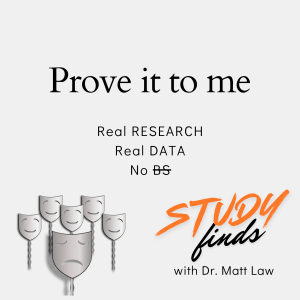
Saturday May 31, 2025
Saturday May 31, 2025
In this #StudyFinds episode of #ProveItPod, Dr. Matt Law attempts to make sense of a meme that claims recent research has found that roasting your friends makes you more loyal and trustworthy. Listen now to find out!
Episode Resources:
Gorman, G., & Jordan, C. H. (2015). “I know you’re kidding”: Relationship closeness enhances positive perceptions of teasing. Personal Relationships, 22(2), 173–187. https://doi.org/10.1111/pere.12071
Johannessen, E. M. V. (2021). Blurred lines: The ambiguity of disparaging humour and slurs in Norwegian high school boys’ friendship groups. Young. https://doi.org/10.1177/11033088211006924
Ledet, B. (2025, March 6). Blair’s social second: Do you insult or roast your friends for fun? FOX 2 Now, Nextar Media Inc. https://fox2now.com/am-show/social-second/blairs-social-second-do-you-insult-or-roast-your-friends-for-fun/
Murti, A. (2020, February 17). Research shows we all should absolutely, relentlessly roast our friends. The Swaddle. https://www.theswaddle.com/why-do-friends-roast-each-other
Platt, M., Malecki, C. K., Luckner, A., Wiemer, K., & Pyun, Y. (2022). You can’t sit with us…just kidding! An investigation into the association between empathy and prosocial teasing. Psychology in the Schools, 59(4), 832–844. https://doi.org/10.1002/pits.22650
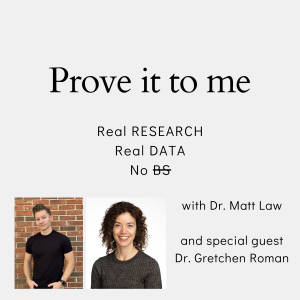
Friday May 02, 2025
Friday May 02, 2025
In this brand new episode of #ProveItPod, Dr. Matt Law talks to Dr. Gretchen Roman about original qualitative research into musculoskeletal disorders and psychosocial hazards among sign language interpreters. Can Total Worker Health® help us better understand the physical and mental health of this population?
Listen now at www.proveitpod.com or wherever you get your podcasts!
About Dr. Roman:
Dr. Roman received her doctoral training at Massachusetts General Hospital, Institute for Health Professions and Arizona State University, College of Health Solutions. She completed her postdoctoral training at the University of Rochester where she investigated the occupational health of sign language interpreters working remotely in response to the COVID-19 pandemic and the impact of a mindful practice intervention on the well-being of medical sign and spoken language interpreters. Dr. Roman is an Assistant Professor in the Department of Family Medicine Research with a dual appointment in the Department of Public Health Sciences at the University of Rochester. Her background includes roles as a physical therapist, orthopaedic clinical specialist, ergonomics consultant, and sign language interpreter. Currently, she is focused on a Mentored Research Scientist Development Award (K01) through the Centers for Disease Control and Prevention’s National Institute of Occupational Safety and Health adapting a previously developed Total Worker Health® program to the context of sign language interpreting.
Episode Resources:
Roman G, Demian C, Love T, Yousefi-Nooraie R. Occupational safety, health, and well-being concerns and solutions for management reported by sign language interpreters: A qualitative study. International Journal of Environmental Research and Public Health. 2024; 21(11):1400. https://doi.org/10.3390/ijerph21111400
Dr. Gretchen Roman – University Profile Page https://www.urmc.rochester.edu/people/112363481-gretchen-a-roman
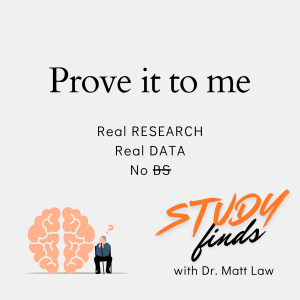
Friday Apr 18, 2025
Friday Apr 18, 2025
In this #StudyFinds episode of #ProveItPod, Dr. Matt Law digs into a study that suggests married folks are at a higher risk of dementia. Is it true? Listen now to find out!
Episode Resources:
George, J. (2025, March 25). Surprising findings from new research about dementia and marriage - U.S. study could challenge the belief that marriage protects against cognitive decline. MedPage Today. https://www.medpagetoday.com/neurology/dementia/114820
Karakose, S., Luchetti, M., Stephan, Y., Sutin, A. R., & Terracciano, A. (2025, March 20). Marital status and risk of dementia over 18 years: Surprising findings from the National Alzheimer's Coordinating Center. Alzheimer's & Dementia, 21(3). https://doi.org/10.1002/alz.70072
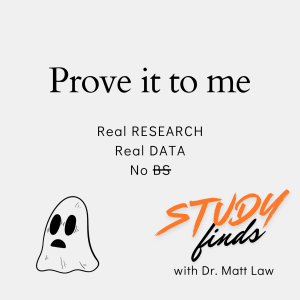
Wednesday Apr 02, 2025
Wednesday Apr 02, 2025
In Part 2 of this #StudyFinds episode of #ProveItPod, Dr. Matt Law continues exploring scare tactics used in workplace safety training and ends up putting his own foot in his mouth. Is this guy even credible? Listen now to find out!
Episode Resources:
Health Communication Capacity Collaborative. (2014). The extended parallel processing model: An HC3 research primer. https://www.healthcommcapacity.org/wp-content/uploads/2014/09/Extended-Parallel-Processing-Model.pdf
Fredrickson, B. L., Cohn, M. A., Coffey, K. A., Pek, J., & Finkel, S. M. (2008). Open hearts build lives: Positive emotions, induced through loving-kindness meditation, build consequential personal resources. Journal of Personality and Social Psychology, 95(5), 1045-1062. https://doi.org/10.1037/a0013262
Lally, P., van Jaarsveld, C. H. M., Potts, H. W. W., & Wardle, J. (2010). How are habits formed: Modelling habit formation in the real world. European Journal of Social Psychology, 40(6), 998–1009. https://doi.org/10.1002/ejsp.674
Law, M. (2020). Four reasons OSH professionals must be better salespeople. Professional Safety, 65(2), 28-31.
Li, S.-C. S., Lu, P.-C., & Chen, S.-C. (2020). Emotions in fear appeals: Examining college students’ attitudes and behavioural intentions towards colorectal cancer prevention in Taiwan. Health Education Journal, 79(5), 569–582. https://doi.org/10.1177/0017896919891749
Liang, S., Raymond Rui, J., & Xu, P. (2022). Risk or Efficacy? How risk perception and efficacy beliefs predicted using hearing protection devices among different groups of Chinese workers. Safety Science, 154, 105858-. https://doi.org/10.1016/j.ssci.2022.105858
Page-Bottorff, T. (2016). The habit of safety: Forming, changing & reinforcing key behaviors. Professional Safety, 61(2), 42-43.
Trope, Y., & Liberman, N. (2010). Construal-Level Theory of Psychological Distance. Psychological Review, 117(2), 440–463. https://doi.org/10.1037/a0018963
Worthington, A. K. (2023). 5.1: Fear appeals – The extended parallel process model. In A. K. Worthington, Persuasion theory in action: An open educational resource (pp. 5.1.1-5.1.5). https://socialsci.libretexts.org/@go/page/179347
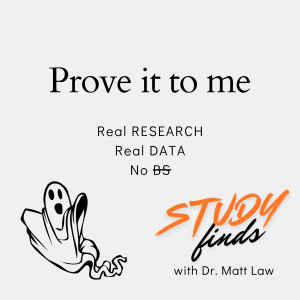
Friday Mar 07, 2025
Friday Mar 07, 2025
In this new #StudyFinds episode of #ProveItPod, Dr. Matt Law does a rapid-fire deep dive into scare tactics used for workplace safety training. Do they work? Listen now to find out!
Episode Resources:
Brookes, G., & Harvey, K. (2015). Peddling a semiotics of fear: a critical examination of scare tactics and commercial strategies in public health promotion. Social Semiotics, 25(1), 57–80. https://doi.org/10.1080/10350330.2014.988920
Carey, R. N., McDermott, D. T., & Sarma, K. M. (2013). The impact of threat appeals on fear arousal and driver behavior: A meta-analysis of experimental research 1990-2011. PloS One, 8(5), e62821–e62821. https://doi.org/10.1371/journal.pone.0062821
Health Communication Capacity Collaborative. (2014). The extended parallel processing model: An HC3 research primer. https://www.healthcommcapacity.org/wp-content/uploads/2014/09/Extended-Parallel-Processing-Model.pdf
Koehler, M., Brockamp, T., Bamberg, S., & Gehlert, T. (2022). Change of risk behaviour in young people – the effectiveness of the trauma prevention programme P.A.R.T.Y. considering the effect of fear appeals and cognitive processes. BMC Public Health, 22(1), 595–595. https://doi.org/10.1186/s12889-022-12918-2
Türkel, S., Misci Kip, S., & Yasdıman, F. E. (2020). Use of fear appeal in work safety messages: An experimental study. Türkiye Iletişim Araştırmaları Dergisi, 36, 253–267. https://doi.org/10.17829/turcom.842695
Worthington, A. K. (2023). 5.1: Fear appeals – The extended parallel process model. In A. K. Worthington, Persuasion theory in action: An open educational resource (pp. 5.1.1-5.1.5). https://socialsci.libretexts.org/@go/page/179347









